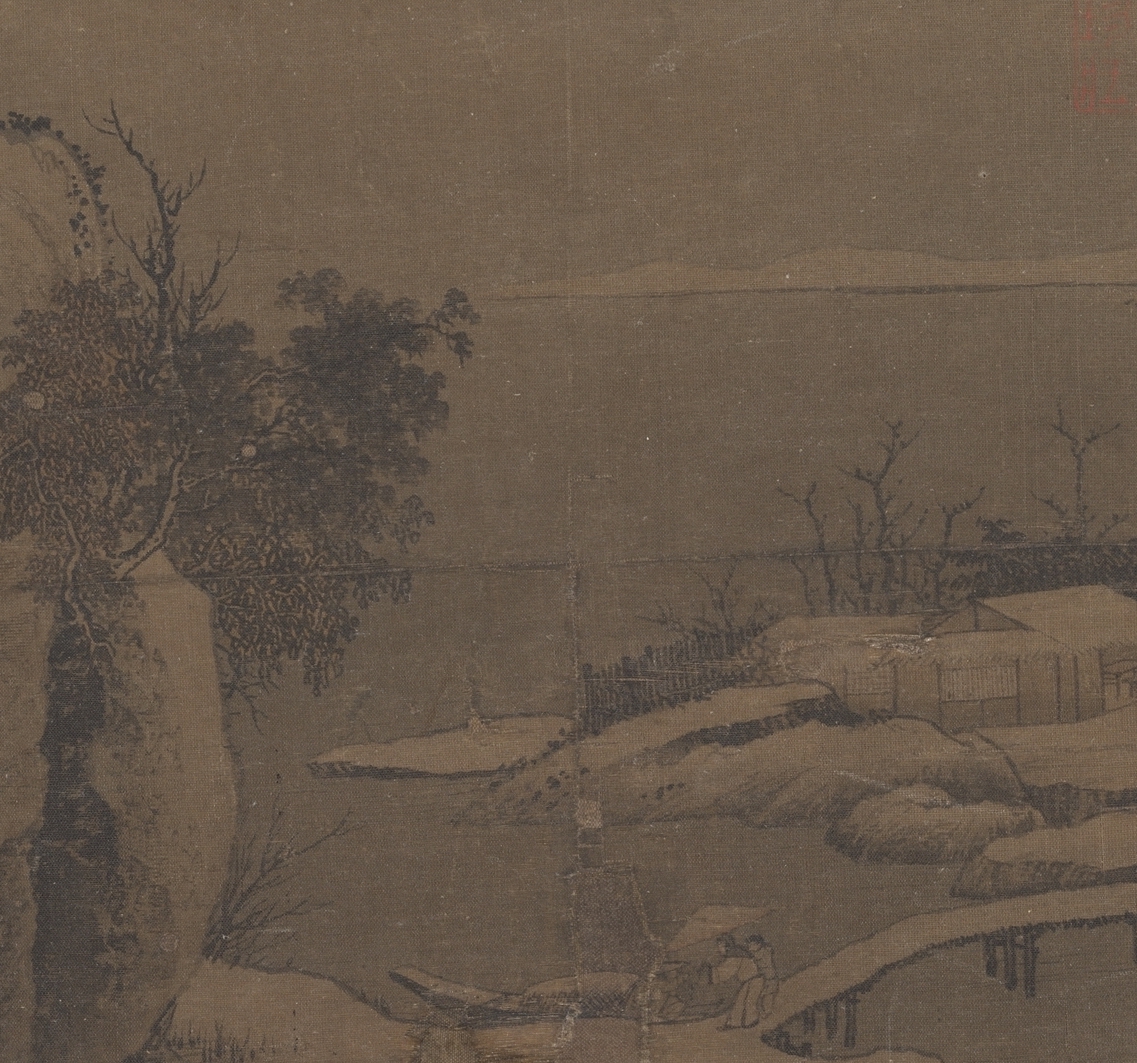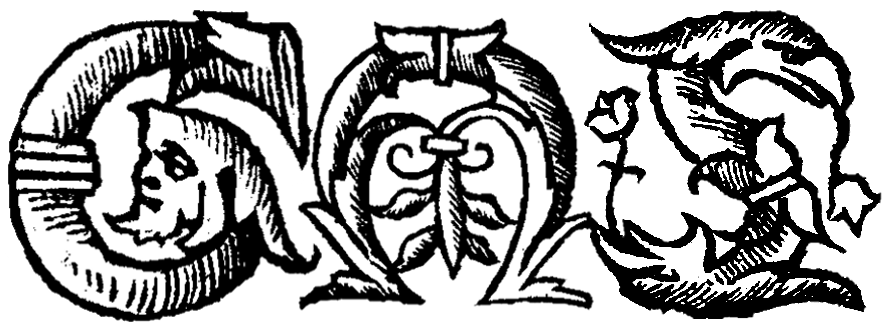To the tune “Waves Scour the Sand”—“I wake from a dream” | 浪淘沙 · 夢覺

Detail from _Bridge in Snow_. Late 10th century. China. Ink and color on silk. 9 3/4 x 10 1/4 in. (24.8 x 26.0 cm). The Metropolitan Museum of Art, New York. Object Number 13.100.116. https://www.metmuseum.org/art/collection/search/51399. [Public Domain]
Read the text (PDF)
Introduction to the Text
Unlike most ci , this one is composed of three stanzas (as are several others by Liu Yong). The first stanza expresses the speaker’s sadness and anxiety when he suddenly wakes up in the middle of the night after drinking to excess. In the second stanza, the speaker reminisces about his old love and old life. The final stanza focuses on the experience of homesickness. Throughout, the poet weaves together feelings of weariness and feelings of longing.
The ci genre of Chinese poetry first emerged in the Sui dynasty (581-619), was further developed in the Tang dynasty (618-907) and matured in the Northern Song dynasty (960-1127). Ci is usually translated into English as “song lyrics”. This is because ci were composed by poets to fit pre-existing tunes. The number of lines, the line lengths, and the tonal and rhythmic patterns of ci vary with the tunes, which number in the hundreds. One common occasion for composing ci would be a banquet: song lyrics would be scribbled down by guests and then sung by musical performers as entertainment. Other occasions for composing and enjoying ci would be more casual: the poet might sing the lyrics to himself at home or while travelling (many ci poets were civil servants of the Imperial Court and often had to travel great distances to carry out their work). Sometimes the lyrics would be sung by ordinary people in the same way as folk songs. This oral and musical quality sets it apart from other genres of poetry in China during the same period, which were largely written texts with more elevated objectives. There are two main types of ci : wǎnyuē (婉约 , “graceful”) and háofàng (豪放 , “bold”). The wǎnyuē subgenre primarily focuses on emotion and many of its lyrics are about courtship and love, while the háofàng subgenre often deals with themes that were considered more profound by contemporary audiences, such as ageing and mortality, or the rewards and disappointments of public service.
Liu Yong was possibly the most widely-read ci writer in the Northern Song period, with fans ranging from courtesans to officials and critics. He excelled in writing love songs, portraying the emotions of lovelorn individuals in unprecedented detail and depth. Despite being born into a family of officials, he did not lead a successful professional life. After he failed keju , the Imperial Chinese civil service examination, he wrote the song “To the tune ‘Crane Soaring in the Sky’”, in which he claimed that ci poets are as important as prime ministers. This led the Ren Emperor of Song 宋仁宗 to personally deem him unfit for imperial service. The emperor suggested that if he really thought that way, he should just be a ci poet instead of pursuing the career of an official. The emperor went so far as to deliberately fail Liu Yong in his following attempt at the exams.
Liu Yong’s continued output of poetry, deemed frivolous, trivial and vulgar by court officials, had a lasting impact on his professional life. He did not pass the civil service exam until he was 48 years old; before that, he spent much of his time with singers and courtesans, writing ci and living a hedonistic existence. After he finally passed keju , he worked as a low rank official in several areas and sought to advance his career through the assistance of the prime minister of that time, Yan Shu, who was also a famous ci poet (and is featured in this collection). Yan Shu mocked the frivolity of Liu Yong’s lyrics and refused to assist him, and the emperor, upon learning of his attempt, commented that Liu Yong, as a ci composer, should stick to composing ci . In response to the emperor’s comment, Liu Yong, in typically rebellious fashion, began signing his ci “composer of ci by imperial decree”. He made a final attempt to salvage his career by writing a complimentary ci to the emperor, but this was regarded as offensive and the emperor stripped him of his official titles and
stated that he would never be accepted back at court. From then on, he returned to his previous lifestyle, indulging in the company of singers and courtesans.
Because of his unique life experience, the sentiments expressed in Liu Yong’s ci are often very different from the views typically expressed in Chinese society at that time, with an especially cynical attitude towards serving the empire and a pronounced defense of hedonism. Nevertheless, Liu Yong’s ci were extremely popular throughout the empire, giving rise to the frequently repeated observation that “if you can see a well in a place, you can hear Liu Yong’s ci being sung there”. As every tiny town had a well, this indicates the wide reach of Liu’s lyrics.
Liu Yong is also notable for his many formal innovations to ci poetry. Before Liu, most ci were written to accompany short tunes, but he initiated a trend of writing lyrics for longer tunes, which allowed for more complex portrayals of human psychology. He was also less restrained by the tune, and often modified the traditional rhyme as well as the line breaks. For example, even when he wrote two ci to the same tune, they might sound very different from one another, with different rhymes, line lengths or numbers of lines. The tunes that Liu Yong used were also more diverse than those of his contemporaries: some were folk songs, and some he composed himself. Many of Liu Yong’s ci have a stronger narrative element, probably due to the influence of storytellers whose street performances he would have watched. Liu received considerable criticism for his focus on love and for his use of commonplace language rather than a refined poetic vocabulary, but this did little to curtail his popularity or his influence on the development of the ci genre.
About this Edition
The original text of this ci is based on the edition by Tang Guizhang 唐圭璋 ( Quan Song Ci 全宋詞 , vol 1. Beijing: Zhonghua shu ju, 1965). Punctuation follows the edition. Since ci poetry rarely includes personal pronouns, and gender-differentiated pronouns did not exist in Classical Chinese of this period, the gender of the speaker as well as their perspective (e.g. first-, second- or third-person) must often be deduced by the translator from context.
Further Reading
Chang, Kang-i Sun. The Evolution of Tz’u Poetry: from Late Tang to Northern Sung . Princeton UP, 1980.
- A standard survey of the early history of Chinese song lyrics (romanized as both ci and tz’u ).
Egan, Ronald. “The Song Lyric”. The Cambridge History of Chinese Literature , vol. 1, edited by Stephen Owen, Cambridge UP, 2010, pp. 434-452.
- An overview of the genre.
Owen, Stephen. Just a Song: Chinese Lyrics from the Eleventh and Early Twelfth Centuries . Asia Center, Harvard UP, 2019.
- A recent new history of the genre.
Tang, Guizhang 唐圭璋 , editor. Quan Song Ci 全宋詞 . Zhonghua shu ju, 1965. 5 vols.
- A comprehensive edition of ci from the Song dynasty and the source text for the ci in this collection (introductions and annotations
are in Chinese).
To the tune “Waves Scour the Sand”—“I wake from a dream” | 浪淘沙 · 夢覺
浪淘沙
夢覺、
透窗風一線,寒燈吹息。那堪酒醒,
又聞空階,夜雨頻滴。嗟因循、
久作天涯客。負佳人、
幾許盟言,便忍把、 從前歡會,
陡頓翻成憂戚。
愁極。 再三追思,洞房深處,
幾度飲散歌闌,香暖鴛鴦被, 豈暫時疏散,費伊心力。 殢雲尤雨,
有萬般千種,相憐相惜。
恰到如今,天長漏永,
無端自家疏隔。知何時、
卻擁秦雲態,願低幃昵枕,輕輕細說與,江鄉夜夜, 數寒更思憶。
To the tune “Waves Scour the Sand”
I wake from a dream,
a thread of wind pierces the window. I blow out the cold lamp.
How can I bear to be sober?
5 Listening to the night rain dripping on the empty steps, sighing that my listlessness
slowly makes me a wanderer at the end of the world. I have let the beautiful girl down—
so many promises.
10 How could I have turned the happy times of the past
so suddenly into worry and regret?
In the gravest sorrow,
I recall again and again, 15 deep in the chamber,
how many times drinks were finished and songs ended. The sweet, warm, mandarin duck quilt.1
Who could have known even a temporary separation would cost her heart’s strength?
20 Cozying up to each other in cloud-and-rain,2 there were a thousand kinds
of love and tenderness.
Yet now
the days are long and the night is dark.
25 For no reason, I am separated from my own lover.
Who knows when
I can embrace the Qin cloud once more?3
I wish to lower the curtains and sink to the pillows, whisper to her softly and slowly
30 about the nights in this river town:
as I counted the coldness,4 I yearned for her more and more.
Critical Notes
-
In traditional Chinese culture, mandarin ducks are believed to be monogamous, unlike other species of ducks. Hence they are regarded as a symbol of conjugal affection and fidelity and frequently fea tured in Chinese art. Quilts with patterns of mandarin ducks are often used in the bedrooms of lovers or married couples.
-
“Cloud and rain” alludes to the Song of Gao Tang (高唐赋 ), a work by Song Yu 宋玉 , who lived during the Warring States period (453–221 BCE). The Song of Gao Tang narrates a brief love affair between the Huai King of Chu 楚怀王 and a mountain fairy which takes place in the king’s dream; in this dream, the mountain fairy describes her residence after their lovemaking as “made from the cloud in the morning, but comprised of rain in the evening”. The imagery of cloud and rain is often used as a euphemism for sexual intercourse in Chinese poetry.
-
“Cloud” refers to sex (see previous note), and “Qin cloud” doubly so because “Qin building” is a name for a brothel. According to legend, the original Qin building was built by the Qinmu King as a palace for his daughter and son-in-law. They were both so good at playing the vertical bamboo flute that their music attracted phoenixes, and the building where they played became famous. The meaning
of the Qin building changed over time, and was later used to refer to brothels.
-
In Chinese culture, winter is divided up into nine periods. These periods are called “nine”, and the winter starts from “the first nine” and ends at “the ninth nine”. There is a tradition for one to count the nines during winter to keep track of how many days have passed since the beginning of winter. Here, “count the coldness” refers to this tradition, implying that the days are becoming colder and colder.
